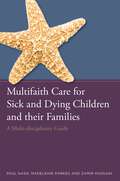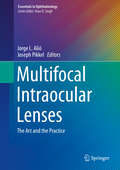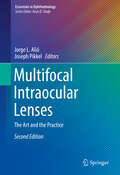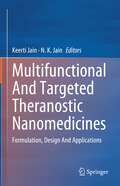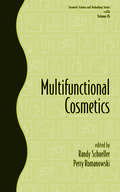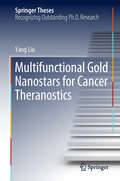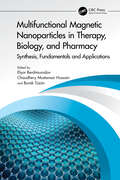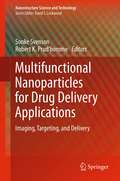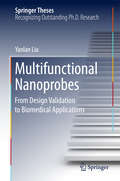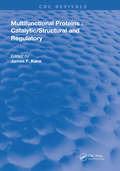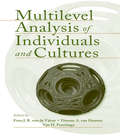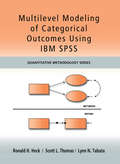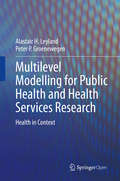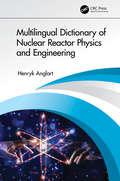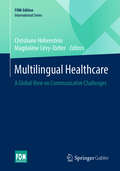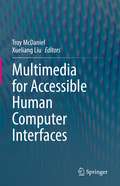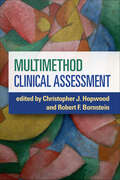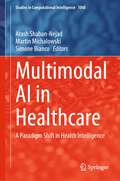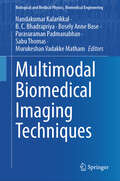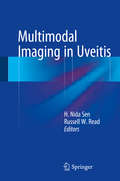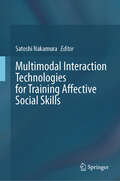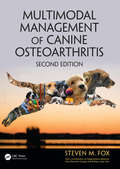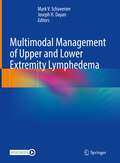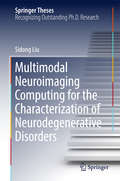- Table View
- List View
Multifaith Care for Sick and Dying Children and their Families: A Multi-disciplinary Guide
by Paul Nash Keith Munnings Rakesh Bhatt Claire Carson Zamir Hussain Parkash Sohal Naomi Kalish Kusumavarsa Hart Madeleine Parkes Surinder SidhuWhat do you need to know in order to provide the best possible care for sick children of different faiths? What, in the context of the young person's faith, might it be helpful to know to support the child and the family, improve care, communicate sensitively and avoid causing offence? Drawing on extensive, evidence-based research and practice, this practical resource addresses the multi-faith needs of sick and dying children and young people in hospitals and the wider community. Covering Islam, Christianity, Hinduism, Sikhism, Judaism and Buddhism, it provides the key information needed to help multi-disciplinary healthcare staff offer the best, culturally-appropriate care to sick children and their families. The book discusses daily, palliative, end of life and bereavement care in a range of settings, including hospitals, hospices, schools and home. The information provided covers those aspects of the religions discussed that are essential for healthcare staff to understand, including modesty and hygiene, taboos, food and prohibited products, age-related issues, sacred objects, visitors, and the expectations of the family. It includes important information on the issues of disability and mental health in each faith as well as addressing the significance within different faith traditions of the transitions from childhood to adolescence to adulthood. A comprehensive resource that uniquely focuses on the care needs of sick children from different faiths, this book will be of immeasurable value to multi-disciplinary healthcare professionals including doctors, nurses, bereavement support and palliative care workers, carers, counsellors, chaplains and arts therapists.
Multifocal Intraocular Lenses
by Jorge L. Alió Joseph PikkelThis book provides the practising ophthalmologist and surgeon with up-to-date information on the use of multifocal intraocular lenses to eliminate pseudophakic presbyopia. Guidance is provided on types and models of intraocular lens, indications, selection of patients, implantation, neuroadaptation and complications and their avoidance. A key goal is to enable the practitioner to select the best lens for the individual patient, taking into account special circumstances. In addition, the results achieved to date with different lenses are analyzed and advice is given on the management of expectations. The authors are acknowledged international experts who draw upon their own experience and the peer-reviewed literature to provide the practitioner with cutting-edge information and evidence-based guidance.
Multifocal Intraocular Lenses: The Art and the Practice (Essentials in Ophthalmology)
by Jorge L. Alió Joseph PikkelThis comprehensive 2nd edition will build on the highly successful first edition, providing an updated global perspective of the fundamentals of multifocal intraocular lenses. The varying outcomes, limitations, and the neuroadaptation process necessary for an adequate clinical success are thoroughly discussed, along with an overview of the different types of multifocal lenses, including the recently developed extended depth of focus lenses.Multifocal Intraocular Lenses: The Art and the Practice, 2nd edition opens with an introduction that will delve into current technological offerings for the correction of pseudophakic presbyopia, as well as the opportunity for refractive lens exchange in advanced presbyopic ages and the opportunity to use these lenses. The first section will include the historical background and clinical indications, while section two addresses the varying types and models of lenses currently available, including important clinical and technological highlights. Section three and four will follow, and provide an extended look at the Zeiss and Alcon Family Multifocal IOL’s. Section five will delve into extended depth of field lenses, and will contain an introduction about the concept, different models and the evidence available about their outcomes. Section six concludes the book, closely examining accommodative intraocular lenses, and a full update will be provided on these lenses, the failures of the past and the hopes for the future. Multifocal Intraocular Lenses: The Art and the Practice, 2nd edition is a thorough, resource for the practical ophthalmologist and ophthalmic surgeon interested in learning more about intraocular lenses, identifying the best technologies and lenses for the benefit of their patients.
Multifunctional And Targeted Theranostic Nanomedicines: Formulation, Design And Applications
by N. K. Jain Keerti JainThis book discusses approaches based on multifunctional and targeted theranostic nanomedicines for improving diagnosis and drug delivery. It explores nanomedicines based on nanocarriers like liposomes, ethosomes, niosomes, polymeric nanoparticles, lipidic nanoparticles, metallic nanoparticles, micelles, dendrimers, quantum dots, carbon-based nanomaterials including carbon nanotubes, carbon dots, carbon quantum dots, graphene oxide, and fullerene. This book reviews designing, conjugation, optimization, formulation and development, and scale-up of multifunctional and targeted theranostic nanomedicines. It examines major challenges in developing nanomaterials that can be applied to nanomedicine with high biocompatibility and biodegradability for diagnostic and therapeutic purposes. Lastly, it addresses the most promising approaches at both commercialization and regulatory steps for bringing theranostic nanomedicine from research laboratories to clinics for patient use.
Multifunctional Cosmetics
by Perry Romanowski Randy SchuellerConsiders groundbreaking developments in cosmeceuticals and the two-in-one shampoo! Multifunctional Cosmetics examines the execution details one should consider when creating multifunctional products shows how to design tests to support claims considers the role of packaging in multifunctional products explores products designed to deliver, enhance
Multifunctional Gold Nanostars for Cancer Theranostics (Springer Theses)
by Yang LiuThis thesis presents the development of theranostic gold nanostars (GNS) for multimodality cancer imaging and therapy. Furthermore, it demonstrates that a novel two-pronged treatment, combining immune-checkpoint inhibition and GNS-mediated photothermal nanotherapy, can not only eradicate primary treated tumors but also trigger immune responses to treat distant untreated tumors in a mouse animal model. Cancer has become a significant threat to human health with more than eight million deaths each year, and novel methods for cancer management to improve patients’ overall survival are urgently needed. The developed multifunctional GNS nanoprobe with tip-enhanced plasmonics in the near-infrared region can be combined with (1) surface-enhanced Raman spectroscopy (SERS), (2) two-photon photoluminescence (TPL), (3) X-ray computed tomography (CT), (4) magnetic resonance imaging (MRI), (5) positron emission tomography (PET), and (6) photothermal therapy (PTT) for cancer imaging and treatment. The ability of the GNS nanoprobe to detect submillimeter intracranial brain tumors was demonstrated using PET scan – a superior non-invasive imaging modality – in a mouse animal model. In addition, delayed rechallenge with repeated cancer cell injection in cured mice did not lead to new tumor formation, indicating generation of a memorized immune response to cancer. The biocompatible gold nanostars with superior capabilities for cancer imaging and treatment have great potential for translational medicine applications.
Multifunctional Magnetic Nanoparticles in Therapy, Biology, and Pharmacy: Synthesis, Fundamentals and Applications
by Chaudhery Mustansar Hussain Elyor Berdimurodov Burak TüzünThis definitive guide provides readers with an overview of multifunctional nanoparticles, delving into their novel synthesis methods, unique properties, and diverse applications in therapy, biology, and pharmacy. It also explores techniques for synthesizing magnetic nanoparticles and explains how to tailor nanoparticles with desired traits.Multifunctional Magnetic Nanoparticles in Therapy, Biology, and Pharmacy: Synthesis, Fundamentals and Applications, explores established and emerging techniques for synthesizing magnetic nanoparticles, enabling readers to understand how to tailor-make nanoparticles with desired traits. Beginning with fundamentals, leading experts delve into topics like recent trends in nanoparticle fabrication, magnetic properties, drug delivery systems, imaging, sensing, separation techniques, toxicity mitigation, and commercial applications. The book showcases the transformative impact and future possibilities of multifunctional magnetic nanoparticles in therapy, biology, and pharmacy. It elucidates the fundamentals behind their magnetic properties and interactions, empowering the development of innovative applications. Detailed chapters highlight their utilization in hyperthermia, cancer therapies, separation and detection of biological molecules and cells, as biocatalysts and in bionanotechnology, antimicrobial agents, sensors, and more.This book is written primarily for scientists, researchers, and engineers working in the fields of nanotechnology, materials science, biomedical engineering, and pharmaceutical sciences. The book covers core principles as well as practical applications, which makes it a valuable textbook or training resource across academic and professional settings in this field.
Multifunctional Nanoparticles for Drug Delivery Applications
by Robert K. Prud'Homme Sonke SvensonThis book clearly demonstrates the progression of nanoparticle therapeutics from basic research to applications. This book, unlike others covering nanoparticles used in medical applications, presents the medical challenges that can be reduced or even overcome by recent advances in nanoscale drug delivery. Each chapter highlights recent progress in the design and engineering of select multifunctional nanoparticles with topics covering targeting, imaging, delivery, diagnostics, and therapy.
Multifunctional Nanoprobes
by Yanlan LiuThis thesis mainly focuses on the design and synthesis of novel multifunctional nanoprobes, investigating their feasibility for applications involving sensing, molecular imaging, and the simultaneous diagnosis and therapy of cancer. Above all, it discusses the development of innovative nanomaterials to address the issues limiting the effectiveness of currently available nanoprobes such as the synthesis shortcoming and poor performance in sensing, imaging and therapeutic applications. One of the strengths of this thesis is its integration of knowledge from chemistry, materials science and biomedicine. Further, it presents the theoretical fundamentals in the design of nanoprobes, which can offer guidance for future studies on the development of novel multifunctional nanomaterials with significantly enhanced performance.
Multifunctional Proteins (Routledge Revivals)
by James F. KaneFirst Published in 1983, this book offers a full, comprehensive guide into proteins and their functions. Carefully compiled and filled with a vast repertoire of notes, diagrams, and references this book serves as a useful reference for Students of Alternative Medicine, and other practitioners in their respective fields.
Multilevel Analysis of Individuals and Cultures
by Ype H. Poortinga Fons J.R. van de Vijver Dianne A. Van HemertIn this book, top specialists address theoretical, methodological, and empirical multilevel models as they relate to the analysis of individual and cultural data. Divided into four parts, the book opens with the basic conceptual and theoretical issues in multilevel research, including the fallacies of such research. Part II describes the methodological aspects of multilevel research, including data-analytic and structural equation modeling techniques. Applications and models from various research areas including control, values, organizational behavior, social beliefs, well-being, personality, response styles, school performance, family, and acculturation, are explored in Part III. This section also deals with validity issues in aggregation models. The book concludes with an overview of the kinds of questions addressed in multilevel models and highlights the theoretical and methodological issues yet to be explored. This book is intended for researchers and advanced students in psychology, sociology, social work, marriage and family therapy, public health, anthropology, education, economics, political science, and cultural and ethnic studies who study the relationship between behavior and culture.
Multilevel Modeling of Categorical Outcomes Using IBM SPSS: Multilevel Modeling Of Categorical Outcomes Using Ibm Spss (Quantitative Methodology Series)
by Scott Thomas Ronald H Heck Lynn TabataThis is the first workbook that introduces the multilevel approach to modeling with categorical outcomes using IBM SPSS Version 20. Readers learn how to develop, estimate, and interpret multilevel models with categorical outcomes. The authors walk readers through data management, diagnostic tools, model conceptualization, and model specification issues related to single-level and multilevel models with categorical outcomes. Screen shots clearly demonstrate techniques and navigation of the program. Modeling syntax is provided in the appendix. Examples of various types of categorical outcomes demonstrate how to set up each model and interpret the output. Extended examples illustrate the logic of model development, interpretation of output, the context of the research questions, and the steps around which the analyses are structured. Readers can replicate examples in each chapter by using the corresponding data and syntax files available at www.psypress.com/9781848729568. The book opens with a review of multilevel with categorical outcomes, followed by a chapter on IBM SPSS data management techniques to facilitate working with multilevel and longitudinal data sets. Chapters 3 and 4 detail the basics of the single-level and multilevel generalized linear model for various types of categorical outcomes. These chapters review underlying concepts to assist with trouble-shooting common programming and modeling problems. Next population-average and unit-specific longitudinal models for investigating individual or organizational developmental processes are developed. Chapter 6 focuses on single- and multilevel models using multinomial and ordinal data followed by a chapter on models for count data. The book concludes with additional trouble shooting techniques and tips for expanding on the modeling techniques introduced. Ideal as a supplement for graduate level courses and/or professional workshops on multilevel, longitudinal, latent variable modeling, multivariate statistics, and/or advanced quantitative techniques taught in psychology, business, education, health, and sociology, this practical workbook also appeals to researchers in these fields. An excellent follow up to the authors’ highly successful Multilevel and Longitudinal Modeling with IBM SPSS and Introduction to Multilevel Modeling Techniques, 2nd Edition, this book can also be used with any multilevel and/or longitudinal book or as a stand-alone text introducing multilevel modeling with categorical outcomes.
Multilevel Modelling for Public Health and Health Services Research: Health in Context
by Alastair H. Leyland Peter P. GroenewegenThis open access book is a practical introduction to multilevel modelling or multilevel analysis (MLA) – a statistical technique being increasingly used in public health and health services research. The authors begin with a compelling argument for the importance of researchers in these fields having an understanding of MLA to be able to judge not only the growing body of research that uses it, but also to recognise the limitations of research that did not use it. The volume also guides the analysis of real-life data sets by introducing and discussing the use of the multilevel modelling software MLwiN, the statistical package that is used with the example data sets. Importantly, the book also makes the training material accessible for download – not only the datasets analysed within the book, but also a freeware version of MLwiN to allow readers to work with these datasets. The book’s practical review of MLA comprises: Theoretical, conceptual, and methodological backgroundStatistical backgroundThe modelling process and presentation of researchTutorials with example datasets Multilevel Modelling for Public Health and Health Services Research: Health in Context is a practical and timely resource for public health and health services researchers, statisticians interested in the relationships between contexts and behaviour, graduate students across these disciplines, and anyone interested in utilising multilevel modelling or multilevel analysis. “Leyland and Groenewegen’s wealth of teaching experience makes this book and its accompanying tutorials especially useful for a practical introduction to multilevel analysis.” ̶ Juan Merlo, Professor of Social Epidemiology, Lund University “Comprehensive and insightful. A must for anyone interested in the applications of multilevel modelling to population health”. ̶ S. (Subu) V. Subramanian, Professor of Population Health and Geography, Harvard University
Multilingual Dictionary of Nuclear Reactor Physics and Engineering
by Henryk AnglartThis multilingual dictionary explains, in simple and clear language, the most frequently used terms and expressions in the field of nuclear reactor physics and engineering, and provides translations of these terms from English into French, German, Swedish and Polish. This unique resource offers many advantages over the use of online translation tools, which are often incorrect when dealing with scientific and technical words. Instead, this dictionary has used a wide variety of peer-reviewed books and journal papers to ensure the highest accuracy and establish itself as a reliable and credible reference for the reader. It covers a broad range of exciting topics and the latest developments in the field, including reactor technology, reactor components and systems, reactor operation and control, reactor types, reactor physics, thermal engineering, reactor safety, radiation protection, nuclear fuel, nuclear chemistry, the safeguarding of nuclear materials and much more. This dictionary is kept on a technical level corresponding to masters-level and PhD studies of nuclear physics and engineering. It will provide the reader with a broad understanding of the necessary information that a researcher or nuclear physicist or engineer would need to possess; therefore, it will be an invaluable resource for students within this and related disciplines. Features: Contains over 1500 key terms from the field The first book to provide translations in five languages: English, French, German, Swedish and Polish Accessible to masters-level and PhD students in addition to early career researchers in nuclear reactor physics and engineering
Multilingual Healthcare: A Global View on Communicative Challenges (FOM-Edition)
by Magdalène Lévy-Tödter Christiane HohensteinThis volume is the first to address multilingual healthcare communication around the globe and focuses on institutional, social and linguistic challenges and resources of the healthcare industry. It comprises studies from Canada, Australia, South Africa, Greenland, Italy, Germany, Switzerland and Belgium, and aims to introduce new paths of communicative and methodological agendas, casting a critical view on current linguistic practices in healthcare, nursing and medical interactions. With increased personal mobility in a global society, the need for multilingual staff is on the rise in medical institutions and healthcare organisations, and communicative competencies and practices involving different languages pose challenges for medical doctors, healthcare staff and patients alike. Many studies have highlighted the crucial role played by interpreters and interpreting staff, but the diversity of language situations in different countries requires very different approaches and solutions. Additionally, it may not be possible to develop a single agenda of language services for different medical areas with different needs for counselling, with various forms of treatment that require explanation and the patient‘s informed consent and with varying approaches to the relationship between medical professionals and patients. How to best organise medical (digital) language services in countries as different as South Africa, Greenland, Germany, Belgium and Australia calls for a diversity of possible solutions. The current volume makes a variety of such solutions and practices available for medical staff and healthcare institutions faced with international patients and working with international medical staff. It makes the challenges palpable on an international scale in a way that comparisons may be drawn between different solutions as well as their socio-cultural and institutional implications. This volume is intended for policy makers, medical and healthcare practitioners, institutions, interpreters, teachers and students in professional multilingual healthcare.
Multimedia for Accessible Human Computer Interfaces
by Xueliang Liu Troy McDanielThe book Multimedia for Accessible Human Computer Interfaces is to be the first resource to provide in-depth coverage on topical areas of multimedia computing (images, video, audio, speech, haptics, VR/AR, etc.) for accessible and inclusive human computer interfaces. Topics are grouped into thematic areas spanning the human senses: Vision, Hearing, Touch, as well as Multimodal applications. Each chapter is written by different multimedia researchers to provide complementary and multidisciplinary perspectives. Unlike other related books, which focus on guidelines for designing accessible interfaces, or are dated in their coverage of cutting edge multimedia technologies, Multimedia for Accessible Human Computer Interfaces takes an application-oriented approach to present a tour of how the field of multimedia is advancing access to human computer interfaces for individuals with disabilities.Under Theme 1 “Vision-based Technologies for Accessible Human Computer Interfaces”, multimedia technologies to enhance access to interfaces through vision will be presented including: “A Framework for Gaze-contingent Interfaces”, “Sign Language Recognition”, “Fusion-based Image Enhancement and its Applications in Mobile Devices”, and “Open-domain Textual Question Answering Systems”. Under Theme 2 “Auditory Technologies for Accessible Human Computer Interfaces”, multimedia technologies to enhance access to interfaces through hearing will be presented including: “Speech Recognition for Individuals with Voice Disorders” and “Socially Assistive Robots for Storytelling and Other Activities to Support Aging in Place”. Under Theme 3 “Haptic Technologies for Accessible Human Computer Interfaces”, multimedia technologies to enhance access to interfaces through haptics will be presented including: “Accessible Smart Coaching Technologies Inspired by Elderly Requisites” and “Haptic Mediators for Remote Interpersonal Communication”. Under Theme 4 “Multimodal Technologies for Accessible Human Computer Interfaces”, multimedia technologies to enhance access to interfaces through multiple modalities will be presented including: “Human-Machine Interfaces for Socially Connected Devices: From Smart Households to Smart Cities” and “Enhancing Situational Awareness and Kinesthetic Assistance for Clinicians via Augmented-Reality and Haptic Shared-Control Technologies”.
Multimethod Clinical Assessment
by Robert F. Bornstein Christopher J. HopwoodFrom leading authorities, this book presents evidence-based strategies for using multimethod assessment to enhance clinical practice. The volume is organized around key assessment targets in the areas of personality, psychopathology, and clinical management (for example, treatment planning and progress monitoring). Each chapter presents multiple methods that are particularly useful for assessing the issue at hand, provides a framework for using these methods together, and reviews the empirical data supporting their integration. Illustrative case examples clarify the approaches described and show how incorporating assessment into treatment can strengthen the therapeutic relationship.
Multimethod Clinical Assessment
by Robert F. Bornstein Christopher J. HopwoodFrom leading authorities, this book presents evidence-based strategies for using multimethod assessment to enhance clinical practice. The volume is organized around key assessment targets in the areas of personality, psychopathology, and clinical management (for example, treatment planning and progress monitoring). Each chapter presents multiple methods that are particularly useful for assessing the issue at hand, provides a framework for using these methods together, and reviews the empirical data supporting their integration. Illustrative case examples clarify the approaches described and show how incorporating assessment into treatment can strengthen the therapeutic relationship.
Multimodal AI in Healthcare: A Paradigm Shift in Health Intelligence (Studies in Computational Intelligence #1060)
by Simone Bianco Arash Shaban-Nejad Martin MichalowskiThis book aims to highlight the latest achievements in the use of AI and multimodal artificial intelligence in biomedicine and healthcare. Multimodal AI is a relatively new concept in AI, in which different types of data (e.g. text, image, video, audio, and numerical data) are collected, integrated, and processed through a series of intelligence processing algorithms to improve performance. The edited volume contains selected papers presented at the 2022 Health Intelligence workshop and the associated Data Hackathon/Challenge, co-located with the Thirty-Sixth Association for the Advancement of Artificial Intelligence (AAAI) conference, and presents an overview of the issues, challenges, and potentials in the field, along with new research results. This book provides information for researchers, students, industry professionals, clinicians, and public health agencies interested in the applications of AI and Multimodal AI in public health and medicine.
Multimodal Biomedical Imaging Techniques (Biological and Medical Physics, Biomedical Engineering)
by Sabu Thomas Parasuraman Padmanabhan Nandakumar Kalarikkal B. C. Bhadrapriya Bosely Anne Bose Murukeshan Vadakke MathamThis book highlights various aspects of multimodal imaging techniques. Innovations and progress in the field of advanced molecular imaging techniques such as Computed Tomography (CT), Magnetic Resonance Imaging (MRI), Positron Emission Tomography (PET), Single-Photon Emission Computed Tomography (SPECT), Fluorescence Imaging, Photoacoustic imaging(PAI), Fluorescence Molecular Tomography (FMT), Ultrasound (US), etc., are covered in this book. This book is an invaluable reference for students, professionals, and research scholars (primarily in the field of materials science, biomedical imaging, and nanoscience and nanotechnology) and also for those who want to nurture their scientific temper/skills in these areas.
Multimodal Imaging in Uveitis
by H. Nida Sen Russell W. ReadThis book is a comprehensive guide to the imaging techniques that have revolutionized the diagnosis and management of uveitis during the past decade, including optical coherence tomography (OCT), enhanced depth imaging, fundus autofluorescence, and wide-field angiography. In addition, the current role of the traditional (invasive) gold standard techniques, fluorescein angiography and indocyanine green angiography, is described. Among the newer imaging modalities, detailed attention is paid to the various OCT technologies such as spectral domain OCT, enhanced-depth imaging OCT, and en face swept-source OCT. Further individual chapters focus on imaging using adaptive optics, multiview OCT, and OCT angiography. Increasing use and better understanding of the different modalities described in this book are sure to improve our knowledge of the disease mechanisms involved in uveitis and likely outcomes.
Multimodal Interaction Technologies for Training Affective Social Skills
by Satoshi NakamuraThis book focuses on how interactive, multimodal technology such as virtual agents can be used in training and treatment (social skills training, cognitive behavioral therapy). People with socio-affective deficits have difficulties controlling their social behavior and also suffer from interpreting others’ social behavior. Behavioral training, such as social skills training, is used in clinical settings. Patients are trained by a coach to experience social interaction and reduce social stress. In addition to behavioral training, cognitive behavioral therapy is also useful for understanding better and training social-affective interaction. All these methods are effective but expensive and difficult to access. This book describes how multimodal interactive technology can be used in healthcare for measuring and training social-affective interactions. Sensing technology analyzes users’ behaviors and eye-gaze, and various machine learning methods can be used for prediction tasks. This bookfocuses on analyzing human behaviors and implementing training methods (e.g., by virtual agents, virtual reality, dialogue modeling, personalized feedback, and evaluations). Target populations include depression, schizophrenia, autism spectrum disorder, and a much larger group of social pathological phenomena.
Multimodal Management of Canine Osteoarthritis (Manson Ser.)
by Steven M. FoxMultimodal Management of Canine Osteoarthritis, Second Edition takes an evidence-based approach to the canine patient with osteoarthritis, pursuing the objective of the best available medicine by a variety of means: multiple drugs, agents, adjuncts and delivery methods. Appreciating that surgical intervention may initially be required, particularly for stabilizing a joint, the major focus in this work is the conservative management of osteoarthritis. A clear and visual approach is taken with the overlapping of two three-pointed triangles of management: medical and non-medical. The completely updated new edition offers a major new chapter on Regenerative Medicine in collaboration with Drs Sherman Canapp and Brittany Jean Carr. It is recommended for any small animal veterinary practitioner, as well as researchers and students of the RCVS CertAVP.
Multimodal Management of Upper and Lower Extremity Lymphedema
by Mark V. Schaverien Joseph H. DayanIn this concise, accessible, and comprehensive reference, world experts in the field of lymphedema detail all of the non-surgical and surgical approaches to the multidisciplinary management of patients with upper and lower extremity lymphedema. There is particular focus on the surgical treatments for lymphedema, where the reader is taken step-by-step through illustrated guides for each procedure by the leading experts in the field of lymphedema microsurgery; from patient selection, preoperative evaluation, surgical technique, and postoperative management. The book is strictly organized so that readers can quickly find content and provides readers with the necessary tools and framework to readily apply these innovative and state-of-the art techniques to their patients to optimize outcomes of surgical and non-surgical treatments for their lymphedema patients. Each chapter features a standardized content layout with full-color illustrations and clinical photographs to visually represent the content and includes key tips from experts in lymphedema, accompanied by key video contributions from the authors to demonstrate the surgical techniques. There is key emphasis on advances in our understand of the etiology of lymphedema, the most important surgical topics in lymphedema microsurgery, the current evidence available for the surgical treatment of lymphedema, and recent advances in lymphedema including new pharmacological treatments that target inflammation and fibrosis Edited by leaders in lymphedema microsurgery and contributed to by a multidisciplinary group of international experts to provide a full and comprehensive guide, Multimodal Management of Upper and Lower Extremity Lymphedema is aimed at a wide target audience that includes surgeons that perform lymphedema surgeries, other medical specialties that treat patients with cancer, lymphedema therapists, physical therapists, and occupational therapists, as well as nursing specialties and trainees.
Multimodal Neuroimaging Computing for the Characterization of Neurodegenerative Disorders
by Sidong LiuThis thesis covers various facets of brain image computing methods and illustrates the scientific understanding of neurodegenerative disorders based on four general aspects of multimodal neuroimaging computing: neuroimaging data pre-processing, brain feature modeling, pathological pattern analysis, and translational model development. It demonstrates how multimodal neuroimaging computing techniques can be integrated and applied to neurodegenerative disease research and management, highlighting relevant examples and case studies. Readers will also discover a number of interesting extension topics in longitudinal neuroimaging studies, subject-centered analysis, and the brain connectome. As such, the book will benefit all health informatics postgraduates, neuroscience researchers, neurology and psychiatry practitioners, and policymakers who are interested in medical image computing and computer-assisted interventions.
